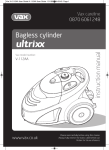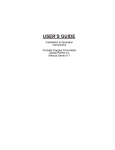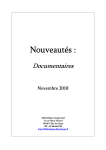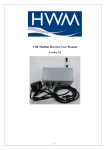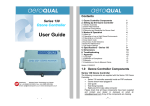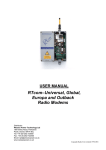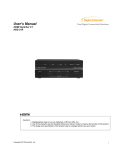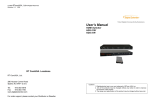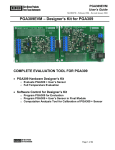Download TAA5 – Telemetry Receiver
Transcript
User Manual RTcomTM-R-O/C Integrated AMR 3–Output Pulse Receiver (open collector) Copyright Radio-Tech Limited 1998-2003 CONTENTS INTRODUCTION 3 Systems 4 Frequency of operation 6 R.F Path Surveys 7 INSTALLATION 8 GENERAL ARRANGEMENT RTcomTM-R-O/C CONNECTIONS 9 10 Pulse outputs Interfacing with current sink devices 12 Interfacing with current source devices 13 Programming 14 RTcomTM-AMR SOFTWARE 15 CONFIGURATION AND PROGRAMMING 16 COMMUNICATION DATA PACKETS Pulse Metering 19 Temperature Measurement 20 Humidity and Temperature Measurement 21 Alarm Monitoring 22 Digital Contact Monitoring 23 EMC Conformity 23 2 INTRODUCTION The RTcomTM-R-OC is a low cost, 3-output pulse receiver with high current open collector outputs, permitting the delivery of pulses from up to three RTcomTM-P remote transmitters, which in turn permit connection to water, gas and electricity meters respectively. In operation the RTcomTM-R is similar in operation to its big brother the RTcom-8Channel AMR receiver, which can operate with up to 8 single or 4 dual-channel RTcomTM-P transmitters. As summary of the key features of the RTcomTM-R are: Encapsulated, IP68++ water proof design Integral robust antenna. Reliable operation down to –20C 12 V dc operation Optically isolated open collector outputs PC programmable transmitter addresses into EEPROM memory via RTcomTM-AMR V5.1 and higher Windows software. Auto pulse count re-synchronization upon power up, with 100ms guaranteed minimum pulse width. Molded in mounting adapter for simple cable tie mounting. Optional serial output data mode for interfacing to a PC. 3 Receive options: The receiver outputs can be used to simply generate pulses upon receipt of transmissions from the programmed transmitter addresses or optionally all three outputs can be combined to produce a single output in a serial ASCII format which can be converted into RS232 level by the addition of a simple pull-up resistor. . Systems The RTcomTM-R-OC operation has been tailored to fit within the requirements of the AMR and sub-metering industries. The receiver firmware supports the programming and decoding of up to three unique transmitter addresses that can be selected anywhere from within our 16-million address range. Once programmed, each output will respond to transmissions received from its corresponding pulse transmitter. Initially the first time the receiver receives a transmission from a registered (one with a programmed address) transmitter, the receivers counter will assume this to be the initial value and synchronise to it. Thereafter any change in the cumulative pulse total received will cause the receiver to generate 100ms duration pulses in a short burst equalling the difference in current pulse count received and that originally stored. By following the above strategy, any transmissions lost due to jamming or clashing will be made up the next time the transmission is received. This ensures that under no circumstances will pulses be lost. IMPORTANT: The receiver should be operated from a battery backed power supply. This is essential as power failure will cause a loss of pulse count. Intentionally if there is a power failure the receiver will reset its totaliser registers to zero to prevent overrun in the event of large differentials in the pulse counts. 4 . Typical Systems Pulse o/p 1 Pulse Meter (1) (Water) Pulse o/p 2 Pulse o/p 3 TM RTcom -R-OC Pulse 3-output receiver. Pulse Meter (2) (Gas) Pulse Meter (3) (Electricity) Pulse metering system with pulse outputs Pulse Meter (1) Serial output levels RS232 TM RTcom -R OC434-Receiver Pulse Meter (3) Pulse metering system with single serial output 5 For extended distance operation the RTcomTM-AMR repeaters can be used. Normally a single repeater can be used per system, however cascaded repeater chains can be created to order. Frequency of operation Often there is little to choose from regarding the operating frequency for licence exempt AMR applications. The RTcomTM-R-OC is available on both of the licence exempt bands available in Europe, 433-435MHz or 868-870MHz UHF. It is also available on the FCC-Part 15 band between 904-920MHz. All of these frequency options match those available on the RTcomTM-P transmitters. In practice unless there is excessive existing traffic, we always recommend the use of the 434MHz band as a preference. A table is given below giving the relative distances between the three operating bands. Free Space Transmission range Industrial installation In large buildings Penetration through concrete walls Ability to bend/ diffracts around obstructions Antenna size (dipole) Potential users in adjacent channels Transmission efficiency For battery operation Relative cost UHF (10mW) 434Mhz Wide Band FM 70-250m UHF (5mW) 869MHz, wide Band FM 50-150m SHF (3mW) 914.5MHz FCC Part 15 30-100m 30-200m 20-120m 20-120m ***** **** **** ***** *** *** 17cm Some Radio Amateur on 433MHz & Tetra ****** 8cm CT2 **** 7.5cm CT2 & Mobile Telephones Toys, Baby alarms etc. **** * ** ** 6 R.F path Surveys & Spectrum scans The only certain way of determining the suitability of a communication channel is to conduct a radio path survey and spectrum scan. The spectrum scan is something normally conducted prior to ordering a system to ensure the radio band is free from other users. However, as by its nature and AMR system is a short-range application, interference is extremely rare and the FM capture effect prevails, (Nearest signal wins). This in most cases obviates the need for a spectrum survey. If a confidence scan is required, both the desired and adjacent channels should be checked for signals. As transmissions may be intermittent it is important to take time with the scan, stopping for as long as possible on each channel and looking for at least 15-minutes on the final chosen band. If there is doubt over the signal reaching the receiver a path survey should be conducted. Normally our AMR collectors, loggers and hand held devices will work satisfactorily with a signal level below 100dBm. In free space this equates to a range of up to 300m. However, within the constraints of a building or a meter pit this can vary from as little as 10m to 100m. The range ultimately depends upon a combination of obstructions and the location of the transmitter with respect to metallic objects and ground level. 7 INSTALLATION The “rubbish in rubbish” rule applies to installing a successful AMR system. Setting up effective and efficient practice is essential in order to get the best and consistent performance out of your RTcomTM-R-OC receiver and -P transmitter/s. The antenna of the receiver is integrated within the narrow, tubular portion of the housing. For maximum transmission range the antenna should point upward (vertically polarised) and should be kept clear of obstructions, in particular metallic surfaces such as manhole covers, ducting and pipes. Mounting can be easily achieved using a cable-tie in either the vertical or horizontal directions as illustrated in the drawing below. Mounting on metallic pipes parallel to the antenna should be avoided if you are looking to achieve maximum distance. Finally, the higher the receiver is mounted the better the reception. Every 3m increase in height normally doubles the operational range. Full mechanical details of the receiver are given on the following page. 8 9 CONNECTIONS TO THE RTcomTM-R-OC The RTcomTM-R-OC receiver is normally supplied with a short length of 7–core data cable, with connections as per table A below. A clean, 8 to 15V dc supply is required to power the receiver at < 30mA typically. This should ideally be battery backed to prevent loss of pulse counts in the event of power failure. The power supply for best performance should be derived from a source clean of RF interference. Switch mode power supplies are notorious for generating noise and causing the “it was working OK yesterday” syndrome. This is due to their interference pattern drifting with temperature and the fact that a CE badge means nothing to a radio receiver, which is capable of operating at signal strengths some 60dB below the noise limits of the EMC Directives. Cable Colour Function/Description Red +12V dc Black Ground Green GND Yellow or Orange RXD (programming input) White TXD (programming ACK) and/or Pulse output 3 Blue Pulse output 2 Purple Pulse output 1 The open collector outputs will normally replicate the closing action of a pulse switch, reed switch, hall effect sensor or transistor driver for terminals designed to operate with volt free contacts. 10 When the receiving terminal itself requires an external wetting voltage the collectors should be pulled up to a suitable dc voltage rail via resistors. Normally we recommend a 4K7 resistor connected to each output. The tolerance and wattage of this resistor is not important and you should choose a device for ease of mounting. The diagrammatic equivalent to receiver outputs are given below: Output 1 Output 2 Output 3 Common RTcomTM-R-OC Connections the receiver outputs for pulse operation 11 Interfacing: current sinking to logic Output 1 Output 2 Output 3 Common RTcomTM-R-OC 12 Interfacing: current source logic Output 1 Output 2 Output 3 Common RTcomTM-R-OC 13 5-12V dc Programming Interface TXD to PC for ACK, Pin 2 RXD, connect to TX on PC, Pin 3 GND connect to GND on PC. Pin 5 RTcomTM-R CONFIGURATION Configuration is normally once only task performed at or before the installation. The process of configuration requires knowledge of the transmitter/s address codes and a copy of our RTcomTM-AMR firmware version 5.1 or above, running on a Windows based PC. A data cable with a pull 4.7K pull up resistor to the receivers power supply is also required. This cable can be supplied to order or easily made up yourself. 14 SOFTWARE INSTALLATION Software installation is simple. The software is normally supplied on CD ROM and normally self install upon insertion of the disk. If the machine fails to launch the auto install click on My Computer and select your CD drive. Clicking on the icon should list the files on the CD. Double click on the set up icon, this will launch an install shield. The install shield will start with text saying “copying files”. This is followed by a dialog box giving you the opportunity to select the destination drive of choice. Once you are happy with the destination, please click OK. Then click on the large left hand button to commence the install. This action will install the programme with one more option box, which once complete will finish with a final OK dialog box. 15 Commissioning and Running RTcomTM-AMR Software To run the program use the start button, select programmes and you should see a programme icon called amr_rtocm. Double clicking on the icon will run the application. 16 The first task is to select the communications port using the top left click box. Normally this will be com1. The date rate should be set to 9600 in order to talk with RTcomTM-R. This is simply selected by clicking on the respective window. The desired receiver addresses should be entered into the three top right hand boxes in the format as written on the transmitters. The mode should also be entered. This is the box that determines if the unit will be a pulse output or a serial output device. Enter addresses Then click Set 3ch Add 17 Enter mode Finally click set mode Mode 0 1 2 3 4 5 6-8 9 Function Receive data from all addresses, HEX serial output Receive data from only programmed addresses, HEX serial only programmed addresses serial output Receives all data outputs in ASCII format Receives only programmed addresses and outputs in ASCII format Receives all data and outputs data with full decode into plain ASCII text strings Receives only programmed address and outputs data with full decode into plain ASCII text strings Not allocated at present Programmed addresses output as pulses All acknowledges will be confirmed with an OK. You are ready to count! 18 Communication Data Packets The receiver 'listens' to messages being transmitted by the transmitters, decodes and validates them by checking the CRC. Once validated the packet is transmitted out of the communications port. The packets vary depending on the type of transmitters. Pulse metering: ID ----ADDRESS------ Status ------Pulse Count------- Ctr -----CRC----- $81 $00 $12 $23 $00 $01 $12 $AA $34 $?? $?? $81 $01 $22 $00 $00 $00 $00 $01 $38 $?? $?? Where taking line 1 as way of example Type 81 = pulse transmitter Address = 001223(Hex) Status = Low Battery and Firmware Revision Number Bit 7 set for low battery Bits 0-3 indicate the firmware revision number Pulse count = 0112AA(Hex) 70314 (decimal) CRC = ???? (dependant upon code content) 19 Temperature measurement: ID ----ADDRESS------ Status -----Temp1------- ----Temp2--- -----CRC----- $82 $00 $12 $23 $00 $FF $73 $00 $34 $?? $?? $82 $01 $22 $00 $00 $00 $20 $00 $38 $?? $?? Where taking line 1 as way of example Type 82 = Temperature transmitter Address = 001223(Hex) Status = Low Battery and Firmware Revision Number Bit 7 set for low battery Bits 0-3 indicate the firmware revision number Temp1 = FFC3 where FF indicates negative temperature C3 (=195 decimal) translates as (256–195) )/2 = -30.5C (decimal) Temp2 = 0034 where 00 = +ve temperature 34 = 34(hex)/2 = 26C (decimal) CRC = ???? (dependant upon code content) 20 Humidity & Temperature Measurement: ID ----ADDRESS------ Status ----Humidity---- --Temperature -- -----CRC----- $83 $00 $00 $66 $01 $05 $44 $17 $A9 $FB $5A $83 $00 $00 $64 $01 $04 $AC $18 $C5 $7E $AD Humidity conversion: Humidity (%) = [-0.0000028 x (Measured)2] + [Measured x 0.0405] - 4 Temperature Conversion: Temperature (deg C) = [Measured x 0.01] - 40 Where taking line 1 as way of example: Type 83 = Humidity & Temperature transmitter Address = 000066(Hex) address 102 Status = Low Battery and Firmware Revision Number Bit 7 set for low battery Bits 0-3 indicate the firmware revision number Humidity (measured) = 0544 (Hex) 1348 (decimal) Humidity (%) = [-0.0000028 x 1348 x 1348] + [1348 x 0.0405] - 4 = -5.08789 + 54.594 - 4 = 45.50% Temperature (measured) = 17A9 (Hex) 6057 (decimal) Temperature (deg C) = [ 6057 x 0.01 ] - 40 = 20.57 deg C CRC = ???? (dependant upon code content) 21 Alarm Monitoring: ID ----ADDRESS------ Status ------Pulse Count------- Ctr -----CRC----- $88 $00 $12 $23 $00 $01 $12 $AA $34 $?? $?? $88 $01 $22 $00 $00 $00 $00 $01 $38 $?? $?? Where taking line 1 as way of example Type 88 = alarm transmitter Address = 001223(Hex) Status = Low Battery and Firmware Revision Number Bit 7 set for low battery Bit 4 set for alarm active, clear for ok Bits 0-3 indicate the firmware revision number Pulse count = 0112AA(Hex) CRC = ???? (dependant upon code content ) 22 Contact Monitoring: ID ----ADDRESS------ Status ------Pulse Count------- Ctr -----CRC----- $87 $00 $12 $23 $00 $01 $12 $AA $34 $?? $?? $87 $01 $22 $00 $00 $00 $00 $01 $38 $?? $?? Where taking line 1 as way of example Type 87 = Contact transmitter Address = 001223(Hex) Status = Low Battery and Firmware Revision Number Bit 7 set for low battery Bit 4 set for contact closed, clear for contact open Bits 0-3 indicate the firmware revision number Pulse count = 0112AA(Hex) CRC = ???? (dependant upon code content ) 23 Appendix A A CRC-16 checksum is implemented on every message to detect any bit errors in the message. The checksum calculation is only used to detect errors but cannot correct them. The crc generating polynomial used is: x16 + x15 + x2 + 1 CRC Algorithm : 1. Load a 16 bit register with all 1s’ 2. Exclusive OR the first 8 bit byte with the high order byte of the 16 bit register, putting the result in the 16 bit register 3. Shift the 16 bit register one bit to the right 4. If the bit shifted to the right is a 0 return to step 3 Else Exclusive OR the generating polynomial 1010 0000 0000 0001 with the 16 bit register 5. Repeat steps 3 & 4 until 8 shift have been performed 6. Exclusive OR the next 8 bit byte with the 16 bit register 7. Repeat step 3 through 6 until all bytes of the message have been exclusive OR’d with the 16 bit register and shifted 8 times 8. The contents of the 16 bit register are the 2 byte CRC error check and is added to the message msb first. 24 Visual Basic CRC Routine ' MODBUS CRC Algorithm Function Tcrcgen() Hicrc = &HFF Locrc = &HFF ' Put data received into array For i% = 1 To Len(Outstring) Outarray(i%) = Mid$(Outstring, i%, 1) Hicrc = Hicrc Xor Asc(Outarray(i%)) For Q% = 1 To 8 Carry = Hicrc And &H1 ' Below is Hicrc=((Hicrc shr 1)&$7F) OR ((Locrc & $01) shl 7) Hicrc = Hicrc \ 2 If (Locrc And &H1) <> 0 Then Hicrc = Hicrc Or &H80 End If ' Below is Locrc=(Locrc shr 1) and $7Fh Locrc = Locrc \ 2 If Carry <> 0 Then Locrc = Locrc Xor &HA0 Hicrc = Hicrc Xor &H1 End If Next Q% Next i% End Function 25 ' MODBUS CRC Algorithm Function Rcrcgen() Hicrc = &HFF Locrc = &HFF ' Put data received into array For i% = 1 To (Numchars - 2) ' Ignore header and crc bytes Hicrc = Hicrc Xor Inarray(i%) For Q% = 1 To 8 Carry = Hicrc And &H1 ' Below is Hicrc=((Hicrc shr 1)&$7F) OR ((Locrc & $01) shl 7) Hicrc = Hicrc \ 2 If (Locrc And &H1) <> 0 Then Hicrc = Hicrc Or &H80 End If ' Below is Locrc=(Locrc shr 1) and $7Fh Locrc = Locrc \ 2 If Carry <> 0 Then Locrc = Locrc Xor &HA0 Hicrc = Hicrc Xor &H1 End If Next Q% Next i% If ((Inarray(Numchars - 1)) = Hicrc) And ((Inarray(Numchars)) = Locrc) Then crcpass = True Else crcpass = False End If End Function Copyright Radio-Tech Limited 1998-2003 All information is given in good faith. Equipment should not be used where failure could result in loss of life or damage to the environment. No losses can be accepted for errors or omissions contained in this document. It is the responsibility of the user to confirm licensing and other legal issues. Revision, Issue 1 Distributor: Wessex Power Technology Ltd 189 Ashley Road, Parkstone Poole, Dorset, BH14 9DL Tel: +44 (0)1202 723000 Fax: +44 (0)1202 723400 Email: [email protected] www.wessexpower.co.uk 26



























